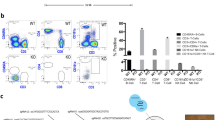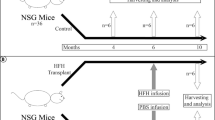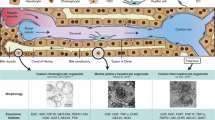Abstract
A strategy for inducing preferential proliferation of the engrafted hepatocytes over host liver cells should markedly increase the benefit of hepatocyte transplantation for the treatment of liver diseases and ex vivo gene therapy. We hypothesized that preparative hepatic irradiation (HIR) to inhibit host hepatocellular regeneration in combination with the mitotic stimulus of host hepatocellular apoptosis should permit repopulation of the liver by transplanted cells. To test this hypothesis, congeneic normal rat hepatocytes were transplanted into UDP-glucuronosyltransferase (UGT1A1)-deficient jaundiced Gunn rats (a model of Crigler-Najjar syndrome type I), following HIR and adenovirus-mediated FasL gene transfer. Progressive repopulation of the liver by engrafted UGT1A1-proficient hepatocytes over 5 months was demonstrated by the appearance of UGT1A1 protein and enzyme activity in the liver, biliary bilirubin glucuronides secretion, and long-term normalization of serum bilirubin levels. This is the first demonstration of massive hepatic repopulation by transplanted cells by HIR and FasL-induced controlled apoptosis of host liver cells.
This is a preview of subscription content, access via your institution
Access options
Subscribe to this journal
Receive 12 print issues and online access
$259.00 per year
only $21.58 per issue
Buy this article
- Purchase on Springer Link
- Instant access to full article PDF
Prices may be subject to local taxes which are calculated during checkout







Similar content being viewed by others
References
Strom SC et al. Hepatocyte transplantation as a bridge to orthotopic liver transplantation in terminal liver failure. Transplantation 1997; 63: 559–569.
Fox IJ et al. Treatment of the Crigler-Najjar syndrome type I with hepatocyte transplantation [see comments]. N Engl J Med 1998; 338: 1422–1426.
Gupta S, Gorla GR, Irani AN . Hepatocyte transplantation: emerging insights into mechanisms of liver repopulation and their relevance to potential therapies [in process citation]. J Hepatol 1999; 30: 162–170.
Grossman M et al. A pilot study of ex vivo gene therapy for homozygous familial hypercholesterolaemia [see comments]. Nat Med 1995; 1: 1148–1154.
Chowdhury JR et al. Human hepatocyte transplantation: gene therapy and more? Pediatrics 1998; 102: 647–648.
Rhim JA et al. Replacement of diseased mouse liver by hepatic cell transplantation. Science 1994; 263: 1149–1152.
Overturf K et al. Hepatocytes corrected by gene therapy are selected in vivo in a murine model of hereditary tyrosinaemia type I [see comments] [published erratum appears in Nat Genet 1996;12:458]. Nat Genet 1996; 12: 266–273.
Mignon A et al. Selective repopulation of normal mouse liver by Fas/CD95-resistant hepatocytes. Nat Med 1998; 4: 1185–1188.
Oren R et al. Restoration of serum albumin levels in nagase analbuminemic rats by hepatocyte transplantation. Hepatology 1999; 29: 75–81.
Guha C et al. Liver irradiation: a potential preparative regimen for hepatocyte transplantation. Int J Radiat Oncol Biol Phys 2001; 49: 451–457.
Guha C et al. Normal hepatocytes correct serum bilirubin after repopulation of Gunn rat liver subjected to irradiation/partial resection. Hepatology 2002; 36: 354–362.
Itoh N et al. The polypeptide encoded by the cDNA for human cell surface antigen Fas can mediate apoptosis. Cell 1991; 66: 233–243.
Leithauser F et al. Constitutive and induced expression of APO-1, a new member of the nerve growth factor/tumor necrosis factor receptor superfamily, in normal and neoplastic cells. Lab Invest 1993; 69: 415–429.
Ogasawara J et al. Lethal effect of the anti-Fas antibody in mice [published erratum appears in Nature 1993 365:568]. Nature 1993; 364: 806–809.
Galle PR et al. Involvement of the CD95 (APO-1/Fas) receptor and ligand in liver damage. J Exp Med 1995; 182: 1223–1230.
Suda T, Nagata S . Purification and characterization of the Fas-ligand that induces apoptosis. J Exp Med 1994; 179: 873–879.
Suda T et al. Molecular cloning and expression of the Fas ligand, a novel member of the tumor necrosis factor family. Cell 1993; 75: 1169–1178.
Kondo T et al. Essential roles of the Fas ligand in the development of hepatitis [see comments]. Nat Med 1997; 3: 409–413.
Demetriou AA et al. Survival, organization, and function of microcarrier-attached hepatocytes transplanted in rats. Proc Natl Acad Sci USA 1986; 83: 7475–7479.
Okuyama T et al. Efficient Fas-ligand gene expression in rodent liver after intravenous injection of a recombinant adenovirus by the use of a Cre-mediated switching system. Gene Therapy 1998; 5: 1047–1053.
Larregina AT et al. FasL induces Fas/Apo1-mediated apoptosis in human embryonic kidney 293 cells routinely used to generate E1-deleted adenoviral vectors. Gene Ther 1998; 5: 563–568.
Mitchell C et al. Therapeutic liver repopulation in a mouse model of hypercholesterolemia. Hum Mol Genet 2000; 9: 1597–1602.
Chen SJ, Tazelaar J, Wilson JM . Selective repopulation of normal mouse liver by hepatocytes transduced in vivo with recombinant adeno-associated virus. Hum Gene Ther 2001; 12: 45–50.
Liu ZX et al. Fas- and tumor necrosis factor receptor 1-dependent but not perforin- dependent pathways cause injury in livers infected with an adenovirus construct in mice. Hepatology 2000; 31: 665–673.
Watanabe-Fukunaga R et al. The cDNA structure, expression, and chromosomal assignment of the mouse Fas antigen. J Immunol 1992; 148: 1274–1279.
Guha C et al. Amelioration of radiation-induced liver damage in partially hepatectomized rats by hepatocyte transplantation. Cancer Res 1999; 59: 5871–5874.
Buckner CD et al. Allogeneic marrow transplantation for acute non-lymphoblastic leukemia in relapse using fractionated total body irradiation. Leuk Res 1982; 6: 389–394.
Deeg HJ et al. Marrow transplantation for acute nonlymphoblastic leukemia in first remission: toxicity and long-term follow-up of patients conditioned with single dose or fractionated total body irradiation. Bone Marrow Transplant 1986; 1: 151–157.
Lawrence TS et al. Hepatic toxicity resulting from cancer treatment. Int J Radiat Oncol, Biol, Phys 1995; 31: 1237–1248.
Lawrence TS et al. The use of 3-D dose volume analysis to predict radiation hepatitis. Int J Radiat Oncol, Biol, Phys 1992; 23: 781–788.
Dawson LA et al. Escalated focal liver radiation and concurrent hepatic artery fluorodeoxyuridine for unresectable intrahepatic malignancies. J Clin Oncol 2000; 18: 2210–2218.
Fajardo LF, Colby TV . Pathogenesis of veno-occlusive liver disease after radiation. Arch Pathol Lab Med 1980; 104: 584–588.
Berry MN, Friend DS . High-yield preparation of isolated rat liver parenchymal cells: a biochemical and fine structural study. J Cell Biol 1969; 43: 506–520.
Miyazaki J et al. Expression vector system based on the chicken beta-actin promoter directs efficient production of interleukin-5. Gene 1989; 79: 269–277.
Chowdhury JR et al. Bilirubin mono- and diglucuronide formation by human liver in vitro: assay by high-pressure liquid chromatography. Hepatology 1981; 1: 622–627.
Roy Chowdhury J et al. Isolation and characterization of multiple forms of rat liver UDP-glucuronate glucuronosyltransferase. Biochem J 1986; 233: 827–837.
Author information
Authors and Affiliations
Additional information
Supported by NIH Grants DK 34357 (to NRC), DK 46057 (to JRC), and P30-DK 41296 (Liver Research Core Center, Director, D.A. Shafritz) and an American Cancer Society grant RPG-00-066-01-CCE (to CG)
Rights and permissions
About this article
Cite this article
Takahashi, M., Deb, N., Kawashita, Y. et al. A novel strategy for in vivo expansion of transplanted hepatocytes using preparative hepatic irradiation and FasL-induced hepatocellular apoptosis. Gene Ther 10, 304–313 (2003). https://doi.org/10.1038/sj.gt.3301909
Received:
Accepted:
Published:
Issue Date:
DOI: https://doi.org/10.1038/sj.gt.3301909
Keywords
This article is cited by
-
Liver Repopulation: A New Concept of Hepatocyte Transplantation
Surgery Today (2005)
-
Hepatocyte transplantation for total liver repopulation
Journal of Hepato-Biliary-Pancreatic Surgery (2005)
-
Liver gene therapy: advances and hurdles
Gene Therapy (2004)



